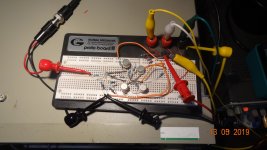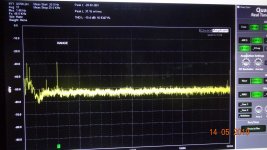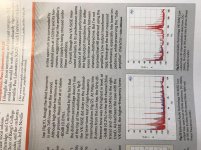In the spirit of being open minded, given that I expect that from others regarding some of my findings, it would seem that you have a 'problem' with your digital sources. I am not surprised, because almost all digital sources add digital artifacts that are annoying, even at an unconscious level. That is why many people do not like to listen to digital sources over long periods. However, adding a cassette tape, even at double speed (commendable) but with Dolby C added, just adds too much distortion, both nonlinear and to the transients, as well to consider it not hi fi reproduction anymore.
I have a Telefunken Ge based portable radio in my living room at the moment, that does much the same thing with FM sources. Yes, they generally sound 'better' through it, but it is not because it has improved the digital source exactly.
I have a Telefunken Ge based portable radio in my living room at the moment, that does much the same thing with FM sources. Yes, they generally sound 'better' through it, but it is not because it has improved the digital source exactly.
Adding 0.6% THD to the original 0.003% of a cd player as my Pioneer deck can do it's not a technical improvement...Its just adding a pleasant color to your sound , the same as vinyl or valve amps.
Hello,
I have been wondering why i never see this fet vs bipolar harmonic differences. I mean, low high-order harmonics only from fet?
Since the mid 1970's, I only use inherently linear topologies; Symmetrical, compl., push-pull types, etc. Maybe I would see the differences only in single-ended amp stages.
I threw together, the 4 transistor CMA exactly as published in TAA preamp art. using 2N2219A/2N2905A but not matched as compliments. As they came from mfr, there is a 20% Hfe difference between P and N types. At that time I didnt have an FFT. Just THD +N. So, lets see what an FFT shows;
It produced .0045% THD at any audio freqs. Mostly 2H. Zero high order harmonics. No 5, 7 9th etc. But with better matching or trimming, or other transistors that could be reduced.
But, No high order harmonics are seem. Just 2H and little 3H. Consequently, I still see no significant distortion advantage to using all fet circuits.
THx- RNMarsh
I have been wondering why i never see this fet vs bipolar harmonic differences. I mean, low high-order harmonics only from fet?
Since the mid 1970's, I only use inherently linear topologies; Symmetrical, compl., push-pull types, etc. Maybe I would see the differences only in single-ended amp stages.
I threw together, the 4 transistor CMA exactly as published in TAA preamp art. using 2N2219A/2N2905A but not matched as compliments. As they came from mfr, there is a 20% Hfe difference between P and N types. At that time I didnt have an FFT. Just THD +N. So, lets see what an FFT shows;
It produced .0045% THD at any audio freqs. Mostly 2H. Zero high order harmonics. No 5, 7 9th etc. But with better matching or trimming, or other transistors that could be reduced.
But, No high order harmonics are seem. Just 2H and little 3H. Consequently, I still see no significant distortion advantage to using all fet circuits.
THx- RNMarsh
Attachments
Last edited:
John, I told, several times, that, OMHO, comparing a fresh original master (analog or digital) with a digital copy, the difference is hard to find. Very subtle if any.... it would seem that you have a 'problem' with your digital sources. I am not surprised, because almost all digital sources add digital artifacts that are annoying, even at an unconscious level.
A pince of hardness, sometimes, in the treble, a feeling that is slightly more clinical ? You have to concentrate a lot to perceive the difference.
yes, the difference is VERY subtle in 44.1 16bits, and the same order than an added analog stage with 24/96. (the one after the DAC ?) Means...near nothing and, on my opinion, in the analog part of the process.. Really nothing as long you stray in digital, making hundred of copies of copies if you like.
While the same copy, with the best analog tape recorder you can find, can be discriminated by anybody, immediately.
Not to talk about the massacre of this master after a vinyl copy ;-)
So, may-I ask-you a question what "digital artifacts" ?
May-be, and, please, take this question with an open mind, you rather like the artifacts introduced by analog recording and reproducing systems ?
It is very simple to figure-it out: Make an analog copy at 15IPS of a CD you like. Do-you feel the "digital artifacts" had disappeared ?
if yes, you have your answer. I mean, you are free to prefer the sound of the copy, and to dislike the crude reality of the original, but it is not a technical problem with digital.
Listening to an old Beatles tune, remastered in digital from the original tapes is painful. We remember the emotions we feel in our young age listening at "Baby you can drive my car"or "Rock and roll music" in the AM radios...
We discover there were no stereo but a strange 3 premix of instruments left, center & right, that they were not so good musicians than we found at this time, charming but clumsy ;-)
That this added blur was very forgiving, and open door to our imagination, our brain filling in the notes and sounds that were missing. But, sorry, this CD it is what was on the tape at this age.
It is like to look at a newly restored painting of Michael Angelo. Oh, what horrible glaring colors ;-)
Last edited:
... We discover there were no stereo but a strange 3 premix of instruments left, center & right, that they were not so good musicians than we found at this time, charming but clumsy ;-)...
Don't forget the bulk of the Beatles' work were done on 4 track machines (1963-1968), and in the beginning, people were trying to figure out what to do with that "stereo" thingy... 🙂
I have the reverse feeling regarding their musicianship: even though they're no virtuosi by a wide margin, each contribution is actually totally appropriate within the song: e.g. listen to George Harrison's little phrases.
JListening to an old Beatles tune, remastered in digital from the original tapes is painful. We remember the emotions we feel in our young age listening at "Baby you can drive my car"or "Rock and roll music" in the AM radios...
I prefer the modern digital remastered stuff - *much* better...
In fact, we agree. I'am still astonished by this miracle, the incredible atmosphere of any of their songs. And the time machine...I have the reverse feeling regarding their musicianship: even though they're no virtuosi by a wide margin, each contribution is actually totally appropriate within the song: e.g. listen to George Harrison's little phrases.
I was just talking about the virtuosity of the instrumentalists and their mastery, as individuals: We, as well had learned a lot how to ... listen ;-)
It is a strange feeling to feel the exact same atmosphere, sentiments etc. than when we were teens, listening to them (and others). 40 years+ of musical culture.
On my point of view, it was a mistake to had remastered their first songs. Copy of the vinyls of this time, out of an cheap record player with a cristal head would have been more appropriate for me. ;-)
On the contrary, listening to some old tunes from Elvis, I'm surprised to day by the virtuosity of some musicians behind, like Scotty Moore.
In fact, here seems to be the 'problem' with digital. Separation VS "Wall of sound".
Last edited:
Out of a concert of a group, playing "The beatles" in the book, Lord Mc Cartney was interviewed by a journalist, asking-him what he was thinking of this show.
He answered: "We were genius".
And, after a little silence added something like: "Listen, don't take this as a pretentious feeling or autosatisfaction. I don't know from where this music came at this time. For sure, no one of us or even the sum of us. We all had spend the rest of our life to run after this lost miracle."
He answered: "We were genius".
And, after a little silence added something like: "Listen, don't take this as a pretentious feeling or autosatisfaction. I don't know from where this music came at this time. For sure, no one of us or even the sum of us. We all had spend the rest of our life to run after this lost miracle."
Ref #19044 -- and when ac trimmed for lowest distortion, using same 20% transistor mismatch and everything... still only 18 dB gnfb .... shows that maybe it IS the topology more than the devices?
Did you see Samuel Groner's composite op-amp, -180dB noise floor and still no harmonics?
Won't they allow RF in?
No, this is special RF resistive material, so called High Density Fiber.🙂
Did you see Samuel Groner's composite op-amp, -180dB noise floor and still no harmonics?
I'm quite ok with harmonics - they just have to be low order.
I've heard Nelson's big amps playing through a pair of big Dali floor standers. They are truly amazing sounding amps and I hadn't even had a glass of wine.
I've heard Nelson's big amps playing through a pair of big Dali floor standers. They are truly amazing sounding amps and I hadn't even had a glass of wine.
Funny you say that I have never found it to be in that order, the speakers have a very distinctive sound the amp meh unless the combo is pathological.
I'm quite ok with harmonics - they just have to be low order.
I've heard Nelson's big amps playing through a pair of big Dali floor standers. They are truly amazing sounding amps and I hadn't even had a glass of wine.
Talk about harmonics! This is from the latest issue of Stereophile, the review of the Balanced Audio Technology VK-56SE power amp. It got a great review and is "Highly Recommended". Sorry about the picture being sideways, but wanted you to see the THD and IM images. It is a 55w triode amp with only 3db of feedback. $8,495.
Attachments
Talk about harmonics! This is from the latest issue of Stereophile, the review of the Balanced Audio Technology VK-56SE power amp. It got a great review and is "Highly Recommended". Sorry about the picture being sideways, but wanted you to see the THD and IM images. It is a 55w triode amp with only 3db of feedback. $8,495.
Lots of PS IM too, great. Like the Wavac these articles question the sanity of the whole audio business.
Isn't it like any other business? Some people are attracted to expensive crap, there is a market to be exploited.
I’m not talking about nasty harmonic grass. We all find that objectionable at some point. An amplifier circuit that produces seconds, thirds and maybe a trace of 4ths with the rest is in the grass at -100 dB does not sound bad.
(The amps I listened to were the big class A’s - And no, I’m not going all soft and “ subjectivey “)
The plots put up above are truly terrible. Nothing else can be said about them.
(The amps I listened to were the big class A’s - And no, I’m not going all soft and “ subjectivey “)
The plots put up above are truly terrible. Nothing else can be said about them.
- Status
- Not open for further replies.
- Home
- Member Areas
- The Lounge
- John Curl's Blowtorch preamplifier part III



